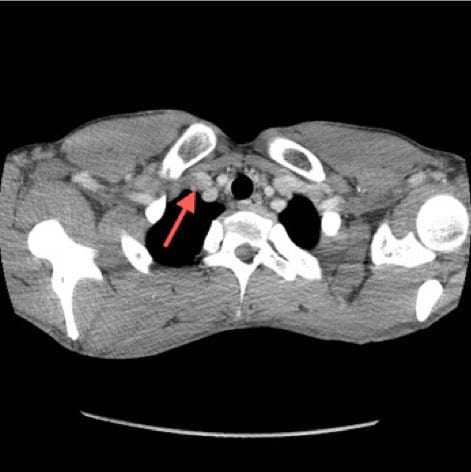| Author | Affiliation |
|---|---|
| Jesse Kellar, MD | Lakeland Regional Medical Center, Department of Emergency Medicine, Saint Joseph, Michigan |
| Christopher Trigger, MD | Lakeland Regional Medical Center, Department of Emergency Medicine, Saint Joseph, Michigan |
CASE
A 19-year-old man presented to the emergency department complaining of two days of right arm pain and swelling. The pain started while lifting weights. He did not experience a pop or pulling sensation. He stated his arm felt a little cold but otherwise denied numbness or tingling. He denied chest pain, neck pain or shortness of breath.
Examination demonstrated a diffusely edematous right upper extremity. Distal pulses were strong and regular. His fingers had a dusky appearance and the entire arm was cool to touch. Range of motion, motor and sensory exam were normal. Heart and lung exam were normal. A computed tomography (CT) angiogram of the chest and upper extremity were performed. The chest CT revealed an axillo-subclavian thrombosis

Figure
Computed tomography angiogram chest reveals a thrombosis of the right subclavian and axillary veins with subtle filling defect at the junction of the right subclavian, jugular and brachiocephalic veins (red arrow).
DIAGNOSIS
Thoracic outlet syndrome (TOS) with secondary Paget Schröetter Syndrome (Effort Thrombosis of the upper extremity)
Upper extremity deep vein thrombosis (DVT) is extremely rare (approximately 2/100,00 people per year), accounting for only 1 to 4% of all cases of DVT.1
Thoracic outlet syndrome is a compression of the neurovascular structures in the area superior to the first rib and posterior to the clavicle. Brachial plexus (95%), subclavian vein (4%), and subclavian artery (1%) are affected. Women more frequently have neurologic thoracic outlet syndrome (TOS) while men more frequently have venous TOS.4
Paget Schröetter Syndrome is an effort-induced thrombosis of upper extremity. First defined in 1884, it was described as a thrombosis of the axillary and subclavian veins. It is the leading vascular disorder in athletes, and males experience it more commonly than females.2,3
Diagnosis and treatment consists of a venous duplex and a confirmatory venogram.2,3 Catheter directed thrombolysis with subsequent first rib removal is recommended to produce the best results.2,3 Oral anticoagulation is generally recommended for 3 to 6 months.
Footnotes
Full text available through open access at http://escholarship.org/uc/uciem_westjem
Address for Correspondence: Jesse Kellar, MD, Lakeland HealthCare, 1234 Napier Ave, Saint Joseph, MI 49085. Email: jkellar@epmg.com. 7 / 2014; 15:364 – 365
Submission history: Revision received February 13, 2014; Submitted March 4, 2014; Accepted April 2, 2014
Conflicts of Interest: By the WestJEM article submission agreement, all authors are required to disclose all affiliations, funding sources and financial or management relationships that could be perceived as potential sources of bias. The authors disclosed none.
REFERENCES
1 Joffe HV, Goldhaber SZ Upper-extremity deep vein thrombosis. Circulation. 2002; 106:1874-1880
2 Urschel HC, Razzuk MA Paget-Schroetter Syndrome: What Is the Best Management?. Ann Thorac Surg. 2000; 69:1663-1669
3 Molina JE, Hunter DW, Dietz CA Paget-Schroetter syndrome treated with thrombolytics and immediate surgery. J Vasc Surg. 2007; 45:328-334
4 Huang JH, Zager EL Thoracic outlet syndrome. Neurosurgery. 2004; 55:897-903


